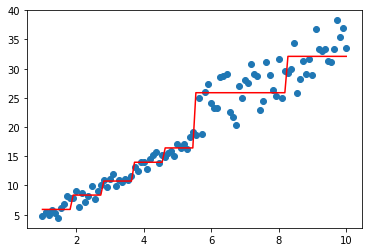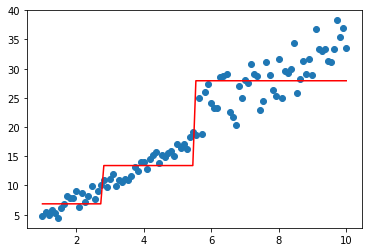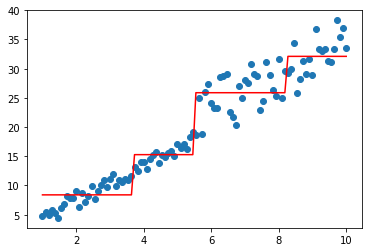标签:检索 node pre else ret image 工业 wrapper ima
xgboost在集成学习中占有重要的一席之位,通常在各大竞赛中作为杀器使用,同时它在工业落地上也很方便,目前针对大数据领域也有各种分布式实现版本,比如xgboost4j-spark,xgboost4j-flink等。xgboost的基础也是gbm,即梯度提升模型,它在此基础上做了进一步优化...
xgboost的损失函数构成如下,即一个经验损失项+正则损失项:
这里\(n\)表示样本数,\(F_{m-1}\)表示前\(m-1\)轮模型,\(f_m\)表示第\(m\)轮新训练模型,所以\(F_m=F_{m-1}+f_m\),\(\Omega(f_m)\)是对第\(m\)轮新训练模型进行约束的正则化项,在前面第6小节做过探索,对损失函数近似做二阶泰勒展开,并对近似损失函数做优化,通常会收敛的更快更好,接下里看下对第\(i\)个样本的经验项损失函数做二阶展开:
这里:
对于第\(m\)轮,\(L(y_i,F_{m-1}(x_i))\)为常数项,不影响优化,可以省略掉,所以损失函数可以表示为如下:
这便是xgboost的学习框架,针对不同问题,比如回归、分类、排序,会有不同的\(L(\cdot)\)以及\(\Omega(\cdot)\),另外由于需要二阶信息,所以\(L(\cdot)\)必须要能二阶可微,接下来对基学习器为决策树的情况做推导
下面推导一下基学习器为回归树的情况,当选择决策树时,它的正则化项如下:
其中,\(j=1,2,...,T\)表达对应的叶节点编号,\(\omega_j\)表示落在第\(j\)个叶节点的样本的预测值,即:
\(I_j\)表示第\(j\)个叶子节点所属区域,所以决策树的损失函数可以改写为如下:
这其实是关于\(\omega\)的一元二次函数,直接写出它的最优解:
这里\(G_j=\sum_{i\in I_j}g_i,H_j=\sum_{i\in I_j}h_i\),可见\(L_2\)正则项起到了缩小叶子节点权重的效果,减少其对整个预测结果的影响,从而防止过拟合,将\(\omega_j^*\)带入可得损失值:
很显然,上面的损失函数可以直接用于特征选择中,对某节点在分裂前的评分为:
分裂后,左右子节点的评分和为:
所以分裂所能带来的增益:
这里\(G=G_L+G_R,H=H_L+H_R\)
这部分对xgboost中的回归树做简单实现,大体流程其实与CART回归树差不多,下面说下它与CART回归树不一样的几个点:
(1)这里fit与之前的CART回归树有些不一样了,之前是fit(x,y),而现在需要fit(x,g,h);
(2)特征选择不一样了,之前是求平方误差的增益,现在需要利用一阶和二阶导数信息,见上面的\(Score\)
(3)叶子节点的预测值不一样了,之前是求均值,现在需利用一阶和二阶导数信息,见上面的\(w_j^*\)
接下来对xgboost所需要用到的回归树做简单实现
import os
os.chdir(‘../‘)
import numpy as np
from ml_models.wrapper_models import DataBinWrapper
"""
xgboost基模型:回归树的实现,封装到ml_models.ensemble
"""
class XGBoostBaseTree(object):
class Node(object):
"""
树节点,用于存储节点信息以及关联子节点
"""
def __init__(self, feature_index: int = None, feature_value=None, y_hat=None, score=None,
left_child_node=None, right_child_node=None, num_sample: int = None):
"""
:param feature_index: 特征id
:param feature_value: 特征取值
:param y_hat: 预测值
:param score: 损失函数值
:param left_child_node: 左孩子结点
:param right_child_node: 右孩子结点
:param num_sample:样本量
"""
self.feature_index = feature_index
self.feature_value = feature_value
self.y_hat = y_hat
self.score = score
self.left_child_node = left_child_node
self.right_child_node = right_child_node
self.num_sample = num_sample
def __init__(self, max_depth=None, min_samples_split=2, min_samples_leaf=1, gamma=1e-2, lamb=1e-1,
max_bins=10):
"""
:param max_depth:树的最大深度
:param min_samples_split:当对一个内部结点划分时,要求该结点上的最小样本数,默认为2
:param min_samples_leaf:设置叶子结点上的最小样本数,默认为1
:param gamma:即损失函数中的gamma
:param lamb:即损失函数中lambda
"""
self.max_depth = max_depth
self.min_samples_split = min_samples_split
self.min_samples_leaf = min_samples_leaf
self.gamma = gamma
self.lamb = lamb
self.root_node: self.Node = None
self.dbw = DataBinWrapper(max_bins=max_bins)
def _score(self, g, h):
"""
计算损失损失评分
:param g:一阶导数
:param h: 二阶导数
:return:
"""
G = np.sum(g)
H = np.sum(h)
return -0.5 * G ** 2 / (H + self.lamb) + self.gamma
def _build_tree(self, current_depth, current_node: Node, x, g, h):
"""
递归进行特征选择,构建树
:param x:
:param y:
:param sample_weight:
:return:
"""
rows, cols = x.shape
# 计算G和H
G = np.sum(g)
H = np.sum(h)
# 计算当前的预测值
current_node.y_hat = -1 * G / (H + self.lamb)
current_node.num_sample = rows
# 判断停止切分的条件
current_node.score = self._score(g, h)
if rows < self.min_samples_split:
return
if self.max_depth is not None and current_depth > self.max_depth:
return
# 寻找最佳的特征以及取值
best_index = None
best_index_value = None
best_criterion_value = 0
for index in range(0, cols):
for index_value in sorted(set(x[:, index])):
left_indices = np.where(x[:, index] <= index_value)
right_indices = np.where(x[:, index] > index_value)
criterion_value = current_node.score - self._score(g[left_indices], h[left_indices]) - self._score(
g[right_indices], h[right_indices])
if criterion_value > best_criterion_value:
best_criterion_value = criterion_value
best_index = index
best_index_value = index_value
# 如果减少不够则停止
if best_index is None:
return
# 切分
current_node.feature_index = best_index
current_node.feature_value = best_index_value
selected_x = x[:, best_index]
# 创建左孩子结点
left_selected_index = np.where(selected_x <= best_index_value)
# 如果切分后的点太少,以至于都不能做叶子节点,则停止分割
if len(left_selected_index[0]) >= self.min_samples_leaf:
left_child_node = self.Node()
current_node.left_child_node = left_child_node
self._build_tree(current_depth + 1, left_child_node, x[left_selected_index], g[left_selected_index],
h[left_selected_index])
# 创建右孩子结点
right_selected_index = np.where(selected_x > best_index_value)
# 如果切分后的点太少,以至于都不能做叶子节点,则停止分割
if len(right_selected_index[0]) >= self.min_samples_leaf:
right_child_node = self.Node()
current_node.right_child_node = right_child_node
self._build_tree(current_depth + 1, right_child_node, x[right_selected_index], g[right_selected_index],
h[right_selected_index])
def fit(self, x, g, h):
# 构建空的根节点
self.root_node = self.Node()
# 对x分箱
self.dbw.fit(x)
# 递归构建树
self._build_tree(1, self.root_node, self.dbw.transform(x), g, h)
# 检索叶子节点的结果
def _search_node(self, current_node: Node, x):
if current_node.left_child_node is not None and x[current_node.feature_index] <= current_node.feature_value:
return self._search_node(current_node.left_child_node, x)
elif current_node.right_child_node is not None and x[current_node.feature_index] > current_node.feature_value:
return self._search_node(current_node.right_child_node, x)
else:
return current_node.y_hat
def predict(self, x):
# 计算结果
x = self.dbw.transform(x)
rows = x.shape[0]
results = []
for row in range(0, rows):
results.append(self._search_node(self.root_node, x[row]))
return np.asarray(results)
下面简单测试一下功能,假设\(F_0(x)=0\),损失函数为平方误差的情况,则其一阶导为\(g=F_0(x)-y=-y\),二阶导为\(h=1\)
#构造数据
data = np.linspace(1, 10, num=100)
target1 = 3*data[:50] + np.random.random(size=50)*3#添加噪声
target2 = 3*data[50:] + np.random.random(size=50)*10#添加噪声
target=np.concatenate([target1,target2])
data = data.reshape((-1, 1))
import matplotlib.pyplot as plt
%matplotlib inline
model=XGBoostBaseTree(lamb=0.1,gamma=0.1)
model.fit(data,-1*target,np.ones_like(target))
plt.scatter(data, target)
plt.plot(data, model.predict(data), color=‘r‘)
[<matplotlib.lines.Line2D at 0x1d8fa8fd828>]

分别看看lambda和gamma的效果
model=XGBoostBaseTree(lamb=1,gamma=0.1)
model.fit(data,-1*target,np.ones_like(target))
plt.scatter(data, target)
plt.plot(data, model.predict(data), color=‘r‘)
[<matplotlib.lines.Line2D at 0x1d8eb88cf60>]

model=XGBoostBaseTree(lamb=0.1,gamma=100)
model.fit(data,-1*target,np.ones_like(target))
plt.scatter(data, target)
plt.plot(data, model.predict(data), color=‘r‘)
[<matplotlib.lines.Line2D at 0x1d8fc9e3b38>]

《机器学习Python实现_10_10_集成学习_xgboost_原理介绍及回归树的简单实现》
标签:检索 node pre else ret image 工业 wrapper ima
原文地址:https://www.cnblogs.com/zhulei227/p/14969706.html